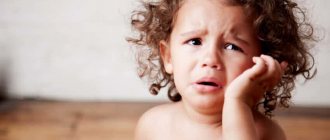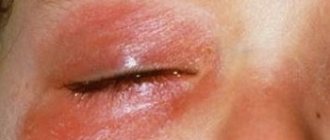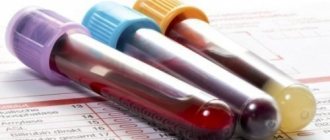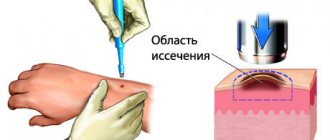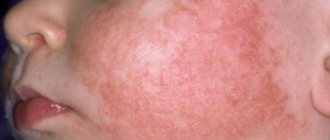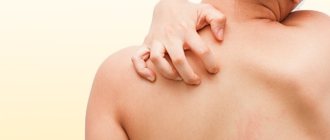Causes of the disease
According to statistics, in most cases, women aged 25 to 50 years and young children suffer from urticaria.
The most common causes of urticaria symptoms on the face and body in a child include:
- food products that can cause allergies - citrus fruits, strawberries, chocolates, yoghurts, sweet pastries, soda, etc.;
- “adult” cosmetic products (shower gels, shampoos, creams, etc.) used for care;
- use of washing powders and other household chemicals not intended for children's clothes;
- carpets, heavy curtains, books and other objects in the child’s room that can accumulate household dust;
- bedding and clothing made of synthetic materials;
- pillows and blankets filled with down and feathers;
- Stuffed Toys;
- pet hair;
- prolonged exposure to the sun or excessively cold conditions.
A rash may appear in an infant if a nursing mother consumes allergenic foods or takes medications without the consent of the doctor.
In adults, in addition to all of the above factors, urticaria can appear in the following cases:
- diseases of the gastrointestinal tract;
- autoimmune diseases (diabetes mellitus, systemic lupus, rheumatoid arthritis, etc.);
- infection with helminths;
- nervous or emotional overexcitation, stress;
- hormonal changes in the body;
- eating salty, smoked, pickled and spicy foods.
Insect bites and plant pollen can cause an allergic reaction in adults and children. Often the cause of skin rashes and itching is living in an environmentally unfavorable environment - near industrial enterprises, highways, etc.
First steps for urticaria
| Form | Characteristic |
| Acute | In a significant proportion of cases, it is of an allergic nature and lasts, depending on the severity of the lesion, from 2-4 hours to 7 days. |
| Chronic | It differs from the acute variety in that it lasts longer (from 1.5-2 to 6 months). The reasons that provoke its appearance are noted:
The chronic form of the disease is characterized by a high probability of relapse, which occurs as a continuation of the acute form of the pathology. |
| Chronic idiopathic urticaria | It is considered a separate type of disease. A special feature is the impossibility of establishing the causes of the pathology. The appearance of this type of skin disease is triggered by physical environmental factors, stressful situations, or taking medications. |
| Papular persistent chronic form | It is distinguished by an expansion of the area of localization of the lesion, presented in the form of a rash of red-pink shades, located both on the surface of the body and limbs, and on the skin of the face. |
A characteristic feature of the course of the disease in pregnant women is an increase in the likelihood of damage to the body during this period of time. This is due to the weakening of the mother's immune system while simultaneously changing her hormonal balance, the purpose of which is to ensure the fetus is fixed in the womb until maturation and birth.
The main danger during pregnancy is not the fact of allergies itself, although it increases the likelihood of allergic reactions in the child in the future, but the choice of medications used to relieve the symptoms of the pathology during this period.
Note! The threat in this case is posed not only by the type of drug used to relieve the symptoms of urticaria, but also by the duration of therapy and dosage of the drug.
In addition, the likelihood of complications increases, the manifestation of which may be difficulty breathing with the development of Quincke's edema, which has a high risk of ending in death.
Considering the dynamic nature of the course of processes during pregnancy, if signs of an increase in an allergic reaction appear, you should immediately seek the help of a qualified specialist.
In general, the likelihood of urticaria during pregnancy can be reduced by limiting the time spent under the influence of direct sunlight, using hypoallergenic cosmetics and household chemicals.
In children
This aspect is worth familiarizing yourself with first. To reduce the risk of developing serious complications, urticaria and Quincke's edema should never be ignored. Emergency care includes the following:
- Call an ambulance.
- Open a window to allow fresh air into the room.
- Give the person's body a comfortable position.
- Avoid contact of the patient with the allergen.
- Give him a special alkaline drink. To prepare it, you need to dilute 1 gram of baking soda per liter of water. This product helps remove allergens from the body, which has a positive effect on well-being and relieves allergy symptoms.
- Give a few tablets of activated carbon to drink.
- Remove any clothing that restricts movement.
- If an allergic reaction occurs after an insect bite, then cold should be applied to it.
- If the victim is conscious, it is necessary to give him any drug that has an antihistamine effect to drink. For example, Suprastin is considered good. You can also give a “Tavergil” injection.
READ MORE: Urticaria in a child. What it looks like, causes, first aid, treatment
It is prohibited to take any other actions until the doctors arrive. They can not only worsen the health condition, but also complicate the diagnosis, making it much more difficult for doctors to help the patient. In some cases, even emergency hospitalization may be required.
During an exacerbation, the skin becomes dry, covered with a crust, which begins to bleed from constant scratching. Droplets of ichor are visible on its surface. The itching worsens at night. The patient's temperature rises, he cannot sleep normally, he feels hot and uncomfortable. The constant itching is exhausting and there is no escape from it. The acute period lasts several weeks.
Urticaria (urticaria) in an advanced stage is manifested by the following symptoms:
- A person wakes up in the morning and sees swelling on the face and body.
- During the day, the skin becomes covered with tubercles and blisters, which turn red in the evening.
- During the night, the blisters swell so much that they completely merge, forming a crust.
- The body is very itchy, the patient cannot sleep normally, often wakes up and scratches the rash.
In severe cases, a person’s lips swell as if they were injected with silicone. Symptoms of a sore throat appear: the neck swells, it hurts to swallow, the voice deepens. If the mucous membranes of the digestive organs swell, diarrhea, bloating, and vomiting occur.
Forms of urticaria
Like other dermatological diseases, urticaria has two forms - acute and chronic.
- the acute form is characterized by the sudden appearance of symptoms, their rapid development (from a few minutes to 1-2 hours) and disappearance after treatment within 1-1.5 months;
- The chronic form is characterized by periodic relapses that can occur over several months or even years.
The risk group for urticaria includes people with a genetic predisposition to allergies. Such individuals should avoid contact with any irritants that may cause urticaria.
How does allergic urticaria appear on the face?
Allergic urticaria is difficult to confuse with a number of diseases.
It is characterized by the development of specific symptoms:
- rashes on the face look like red spots with clear edges. They can be of completely different sizes and tend to merge, forming large spots;
- severe itching. The appearance of this symptom can even lead to a nervous breakdown. Itchy sensations may appear at different times of the day and night. Which often leads to the development of insomnia.
Symptoms of the disease
Both acute and chronic forms of urticaria have the same clinical picture, which is accompanied by the following symptoms:
- the appearance of skin rashes in the form of voluminous blisters of bright pink color;
- skin redness;
- swelling;
- sensation of burning and tightness of the skin;
- pain when touching the affected areas.
Urticaria is always accompanied by itching, which is especially intensified in the evening and at night. Young children often scratch blisters, which leads to open wounds and abrasions that pathogens can easily penetrate. This causes secondary infection and can lead to the development of purulent inflammation, aggravating the course of urticaria.
Often, skin manifestations of urticaria are accompanied by a general deterioration of the condition, characterized by the following signs:
- increased body temperature;
- headache;
- nausea;
- diarrhea;
- muscle and joint pain;
- chills.
In a child, urticaria causes loss of appetite, sleep disturbances, and increased tearfulness. In adults, symptoms of the disease can cause apathy or excessive nervous agitation.
Localized on exposed areas of the body, most often on the neck and cheeks, urticaria leads to swelling of the mucous membranes of the mouth, nose and eyes. As a result, allergic rhinitis develops, accompanied by a strong discharge of mucus, and then congestion of the nasal passages. Patients also experience symptoms of allergic conjunctivitis: swelling of the eyelids, lacrimation, itchy eyes.
An attack of urticaria can provoke swelling of the mucous membranes of the larynx, which leads to difficulty breathing and causes asphyxia. Signs of this condition are a sore throat, a characteristic “barking” cough, and wheezing.
Types of rashes on the lips
Before treating the emerging disease, it is necessary to differentiate the rashes according to their location and the appearance of the pathological process.
Red rash on lips
This defect can develop due to an inadequate reaction of the body to any product or medication.
In these cases, the spots spread not only on the face, but throughout the body. Often, when a large amount of allergen enters the bloodstream, the rash begins to itch, and there is a risk of developing anaphylactic shock or Quincke's edema.

To eliminate the disease, you need to take an antihistamine and consult a doctor.
Semolina-shaped rash on lips
Weakening of the body's defenses, problems with the gastrointestinal tract, and viral diseases can lead to a rash in the form of white grains forming on the lips.
In such cases, it is necessary to visit a dermatologist.
In infants, a white rash on the lips and tongue is a sign of a developing fungal infection (thrush).
In the form of bubbles
The appearance of a rash on the lips in the form of bubbles filled with transparent contents indicates the presence of herpes. When the immune system is weakened, the rashes become noticeable. After a course of therapy, they disappear immediately or after some time.
On the inside of the lip
It can break out in this area after damage - teeth touching the skin, eating hard food, or an accidental blow.
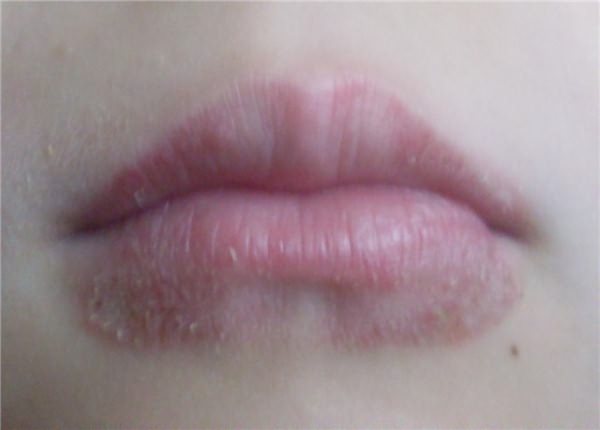
At the site of the wound, a bubble filled with liquid forms, which bursts after a while.
To prevent infection and subsequent suppuration, you must follow the rules of asepsis: do not touch the resulting wound with dirty hands, rinse your mouth after each meal.
The appearance of a rash on the inside of the lip with further development of the pathological process becomes the cause of stomatitis.
Rash on the corners of the lips
Failure to maintain personal hygiene leads to seizures. The rash occurs due to eating dirty vegetables or fruits, and frequent licking of the corners of the lips. Also, the factors that provoke the appearance of the disease include the characteristics of the course of herpes.
Diagnostics
In especially severe cases, urticaria poses a danger not only to health, but also to human life. This is especially true for infants, in whom the disease can develop very quickly. Therefore, it is important, if you are predisposed to allergies or the first symptoms appear, to consult an allergist or dermatologist.
Clinical manifestations of urticaria, as a rule, do not cause the doctor to doubt the diagnosis. It is important to determine the factor that provoked the attack of the disease in order to limit the patient as much as possible from contact with it.
To do this, a series of special tests are carried out:
- subcutaneous injection of various allergens to determine reactions to food, dust, medications, etc.;
- applying pieces of ice to the body to identify cold urticaria;
- ultraviolet irradiation for thermal and solar varieties of the disease;
- rubbing the skin with a blunt object to determine dermatographic, etc.
To find out whether urticaria is a consequence of a chronic disease, the patient is sent for the following laboratory tests:
- general and biochemical blood test;
- general urine analysis;
- fecal analysis for helminthiasis;
- Ultrasound of internal organs.
If necessary, doctors of other specialties are involved to clarify the diagnosis: endocrinologist, immunologist, neurologist, gastroenterologist.
Preventive actions
It is advisable to familiarize yourself with them first in order to understand how you can protect yourself from these ailments. Proper nutrition is aimed at stopping an allergic reaction, but it alone is not enough to cope with the disease.
There are a number of methods for preventing angioedema and urticaria, which will not only increase the effectiveness of treatment, but also reduce the risk of developing these pathologies. Elimination involves the following:
- carrying out wet cleaning in the home;
- compliance with basic rules of personal hygiene;
- wearing loose clothing made from natural materials that does not fit too closely to the body and does not restrict movement;
- minimizing the use of chemicals and household products;
- refusal to use carpets and furniture with soft fabric upholstery;
- avoiding severe overheating or hypothermia of the body;
- regular ventilation of rooms;
- reducing the duration of sessions when visiting a solarium;
- review of the cosmetics and medications used.
All these preventive measures will reduce the likelihood of contact with allergens and reduce the risk of developing allergies. And for urticaria and Quincke's edema, they will make the symptoms less pronounced and speed up the recovery process, provided that the patient carries out treatment and adheres to all the recommendations of his attending physician.
As measures that reduce the likelihood of the disease or the severity of its course, experts call:
- Limit contact with potential allergens.
- Refusal to eat foods for which their reaction to the body is unknown.
- Timely treatment of gastrointestinal diseases and metabolic disorders.
- Diet for women during pregnancy and breastfeeding.
- Carry antihistamines with you if you are prone to allergic reactions.
If the symptoms of the disease have spread to the eyes or lips, you should immediately seek the help of a qualified specialist, since these symptoms indicate the initial stage of Quincke's edema.
Treatment of urticaria
If, as a result of diagnostic measures, the irritant that provoked the appearance of an allergic rash on the face was identified, it is necessary to eliminate contact with it. If urticaria is considered idiopathic (arising for an unknown reason), then the patient is advised to exclude all possible allergens.
In addition, to get rid of rashes, itching and other symptoms in adults and children, the following groups of drugs are prescribed:

During an attack of urticaria, it is recommended to take enterosorbents, which help remove toxins from the body. These drugs include activated carbon, Sorbex, Enterosgel, Polysorb, Smecta, Polyphepan. They can be used to treat patients of any age, even newborns.
In severe cases of urticaria, when conventional antihistamines are not effective, injections of corticosteroids are prescribed - dexamethasone, prednisolone, hydrocortisone. These medications have many contraindications (during pregnancy, lactation, for treating children, etc.), so hormonal therapy is usually carried out in a hospital setting.
Traditional methods will help relieve the symptoms of urticaria on the face. The following are considered the most effective:
- lotions with decoctions of medicinal herbs: string, chamomile, yarrow, lambswort, nettle;
- applications made from raw potatoes, grated on a fine grater;
- compresses with celery juice;
- washing with a decoction of oatmeal.
An important component of therapy for urticaria is a hypoallergenic diet, which completely excludes the consumption of foods that can trigger an attack of the disease.
Useful tips
If you are not sure of the reasons that caused hives, you should not start treatment on your own, otherwise you can easily blur the picture of the disease and, as a result, make it difficult to find the real cause.
If the reason is in face cream or some other product, you should never wash it off with hot water, as this will facilitate the rapid penetration of the allergen into the skin.
Drinking plenty of fluids (water) helps remove the allergen from the body as quickly as possible.
Complications
If the symptoms of urticaria are ignored or treatment is not started in a timely manner, the disease can lead to serious and dangerous consequences. This is especially true for young children, in whom urticaria develops rapidly.
The most serious complications of urticaria are:
- angioedema, in which swelling spreads to the eyes, nasal passages and larynx. If a person is not given help, suffocation may occur;
- anaphylactic shock. Rapid drop in blood pressure, dizziness, loss of consciousness, tachycardia. Requires immediate resuscitation measures as it can lead to the death of the patient.
In addition, penetration of pathogenic microflora into open wounds resulting from scratching leads to the formation of weeping foci of inflammation, suppuration and the appearance of infiltration.
Prevention
It is possible to avoid urticaria if you follow the necessary preventive measures.
These include the following:
- Avoid eating foods that may cause allergies;
- do not take medications without a doctor’s prescription;
- use cosmetics marked “hypoallergenic”;
- do not wear clothes made of synthetic materials;
- avoid excessive hypothermia of the body;
- do not be in the sun without a hat;
- treat the skin with repellents to prevent insect bites;
- avoid nervous and emotional stress;
- do not contact with pets.
In addition, children and adults need to lead an active lifestyle: spend more time in the fresh air and engage in sports. To strengthen the immune system, you should take vitamin complexes, and in case of any ailments, seek medical help and undergo timely treatment.
